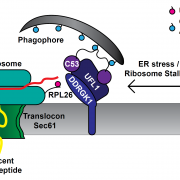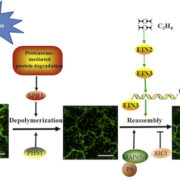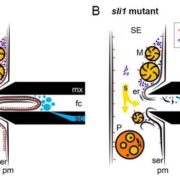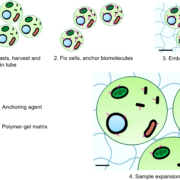GABA signalling modulates stomatal opening to enhance plant water use efficiency and drought resilience (Nature Comms)
 Gamma-aminobutyric acid (GABA) is a non-protein amino acid produced by animals and plants, but is its function conserved across kingdoms? In mammals, GABA acts as chemical messenger in the central nervous system by inhibiting neurotransmission. In plants, GABA accumulates in response to stress but its role in cellular communication is still unresolved. In this study, Xu and coworkers used stomatal guard cells to investigate the function of GABA in plants. Application of exogenous GABA attenuated light-induced stomatal opening in epidermal peels and intact leaves of Arabidopsis. Because stomatal aperture controls water loss, these findings suggested that GABA could play a role in plant response to drought. Arabidopsis gad2 plants with mutations in Glutamate Decarboxylase 2 (GAD2), which encodes the major GABA biosynthetic enzyme, accumulate less GABA in leaves and have increased stomatal aperture. The gad2 mutants also do not accumulate GABA in response to drought treatment and show increased sensitivity to water stress, whereas expression of a constitutively active form of GAD2 in guard cells not only rescued the gad2 phenotype but also improved the recovery of rewatered plants after drought treatment. Additional experiments suggest GABA may function through negative regulation of anion uptake into the guard cell vacuole. The finding that GABA also controls stomatal aperture other dicot and monocot species paves the way for its use to improve water use efficiency and drought resilience in crops. (Summary and image adaptation by Michela Osnato @michela_osnato) Nat. Comms. 10.1038/s41467-021-21694-3
Gamma-aminobutyric acid (GABA) is a non-protein amino acid produced by animals and plants, but is its function conserved across kingdoms? In mammals, GABA acts as chemical messenger in the central nervous system by inhibiting neurotransmission. In plants, GABA accumulates in response to stress but its role in cellular communication is still unresolved. In this study, Xu and coworkers used stomatal guard cells to investigate the function of GABA in plants. Application of exogenous GABA attenuated light-induced stomatal opening in epidermal peels and intact leaves of Arabidopsis. Because stomatal aperture controls water loss, these findings suggested that GABA could play a role in plant response to drought. Arabidopsis gad2 plants with mutations in Glutamate Decarboxylase 2 (GAD2), which encodes the major GABA biosynthetic enzyme, accumulate less GABA in leaves and have increased stomatal aperture. The gad2 mutants also do not accumulate GABA in response to drought treatment and show increased sensitivity to water stress, whereas expression of a constitutively active form of GAD2 in guard cells not only rescued the gad2 phenotype but also improved the recovery of rewatered plants after drought treatment. Additional experiments suggest GABA may function through negative regulation of anion uptake into the guard cell vacuole. The finding that GABA also controls stomatal aperture other dicot and monocot species paves the way for its use to improve water use efficiency and drought resilience in crops. (Summary and image adaptation by Michela Osnato @michela_osnato) Nat. Comms. 10.1038/s41467-021-21694-3









